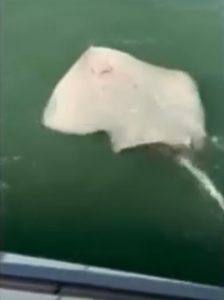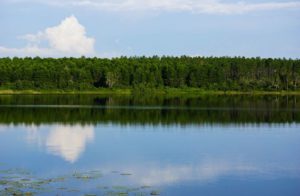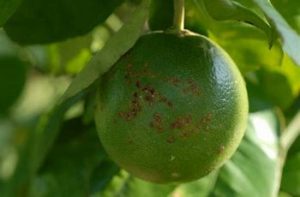Plus, citrus’ hard season
 New findings surrounding the death circles of spinning fish in the Florida Keys point towards seafloor algae, Florida invests billions to support biodiversity and water quality, and the citrus industry continues to feel the strain post-Hurricane Ian. It’s all in this week’s Environmental and Engineering Digest.
New findings surrounding the death circles of spinning fish in the Florida Keys point towards seafloor algae, Florida invests billions to support biodiversity and water quality, and the citrus industry continues to feel the strain post-Hurricane Ian. It’s all in this week’s Environmental and Engineering Digest.

A stingray swimming upside down in the Florida Keys, February 2024. Courtesy, Bonefish & Tarpon Trust
Death Circles in the Keys: In a follow up to our March newsletter story, scientists have been on the hunt for eight months to find what is causing dozens of species of fish to swim in death circles and behave erratically when exposed to light down in the Florida Keys. Now, they think the secret might be seeping up from the sea floor. So far, the only lead is high levels of an algae called Gambierdiscus in water samples from the affected areas, according to multiple researchers, including Alison Robertson, a senior marine scientist at the Dauphin Island Sea Lab. “The hypothesis I’m working on at the moment is really that the combination of these various benthic algal toxins is coming together to create the phenomenon we’re seeing,” she told WBBH-TV. “(There’s] no obvious smoking gun.”
While it’s hard to pin down a definite source, it’s the only evidence so far in the race to save the critically endangered smalltooth sawfish, which seems to be one of the more affected species, losing at least 47 fish to the strange anomaly so far. Robertson added that this is not indicative of an ecological crash, but Florida lawmakers have agreed to put $2 million towards fish research in the Keys to help pinpoint the source of the problem.

The Florida Everglades. Courtesy, Fla. Dept. of Environmental Protection
Billions Towards Biodiversity: Florida lawmakers this past session appropriated $2.25 billion to improve water quality and biodiversity in the state. Governor DeSantis recently announced $1.5 billion towards Everglades restoration – a decisive win for Florida’s environmental stewardship. The funding allocates $850 million for actual restoration, $135 million to remove harmful nutrients from key waterways, and $530 million for targeted water quality improvement projects, which includes septic-to-sewer and wastewater treatment upgrades. This is the largest state investment in a single year since the Comprehensive Everglades Restoration Plan was established in 2000.
 A Strained Citrus Industry: Florida’s citrus industry has had quite a troubled 2024 season, with the May 10th forecast showing another drop in production – down 12.2% from projections at the beginning of last summer. That amounts to one million fewer boxes of oranges and 200,000 fewer boxes of grapefruit from the April forecast – but these are still slight improvements from the 2022-2023 season, which spelled a 93-year low for the state’s production. Citing the downturn, the Gulf Citrus Growers Association and the Peace River Valley Citrus Growers Association recently closed their doors, citing a plethora of reasons, but none more apparent than citrus greening, an arboreal disease which has plagued the industry for more than 20 years, and the lingering effects of Hurricane Ian. “We expect it may take another season, or more, for the groves to fully recover to pre-Hurricane Ian production levels,” said Alico Inc., a major citrus grower based out of Fort Myers that has been working to return fruit yield and quality to its former glory. Their work with antibiotics to counteract citrus greening has led to an increase in citrus yield, and a squeeze of hope for the industry. “We remain optimistic that production will increase next year,” they concluded in a recent public statement.
A Strained Citrus Industry: Florida’s citrus industry has had quite a troubled 2024 season, with the May 10th forecast showing another drop in production – down 12.2% from projections at the beginning of last summer. That amounts to one million fewer boxes of oranges and 200,000 fewer boxes of grapefruit from the April forecast – but these are still slight improvements from the 2022-2023 season, which spelled a 93-year low for the state’s production. Citing the downturn, the Gulf Citrus Growers Association and the Peace River Valley Citrus Growers Association recently closed their doors, citing a plethora of reasons, but none more apparent than citrus greening, an arboreal disease which has plagued the industry for more than 20 years, and the lingering effects of Hurricane Ian. “We expect it may take another season, or more, for the groves to fully recover to pre-Hurricane Ian production levels,” said Alico Inc., a major citrus grower based out of Fort Myers that has been working to return fruit yield and quality to its former glory. Their work with antibiotics to counteract citrus greening has led to an increase in citrus yield, and a squeeze of hope for the industry. “We remain optimistic that production will increase next year,” they concluded in a recent public statement.

